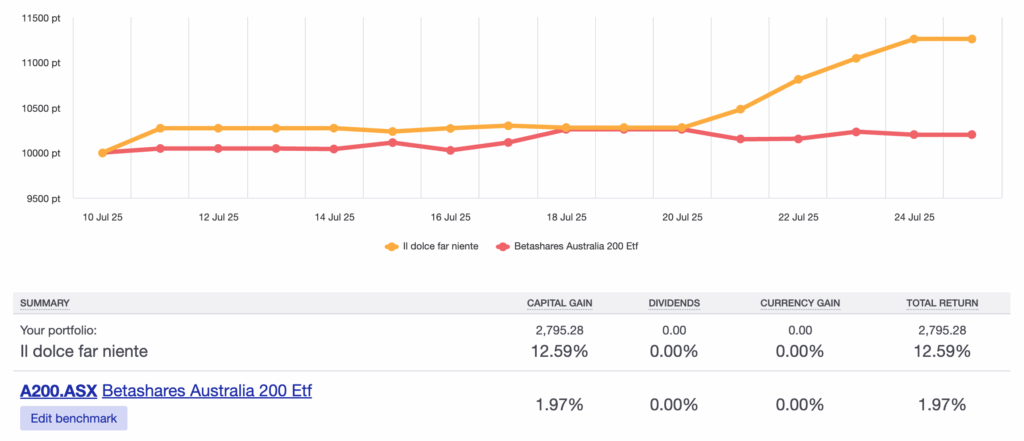My Patient Investing Lab

Hello everyone, and welcome to My Patient Investing Lab!
by Michael Lamonaca 24 July 2025
Today, I wanted to share a look at how my “il dolce far niente” portfolio is performing since its recent inception, alongside a common benchmark. As you can see from the graph, in just a couple of weeks since July 10th, our “il dolce far niente” portfolio has shown a capital gain of 12.59%. For comparison, the Betashares Australia 200 ETF (A200), which is a great, low-cost way to track the top 200 Australian companies, has shown a 1.97% gain over the same short period.
It’s important to remember that for us, capital gain or loss at this stage is largely paper profit or loss, and doesn’t hold much relevance in our long-term strategy. Our core philosophy is to “hold for life” those exceptional businesses that meet our rigorous criteria. We’re not focused on short-term market fluctuations or trying to time the next big move. Instead, we select robust companies, buy them at the right price, and then let them compound our wealth and generate passive income over decades. The real magic happens over the long haul, as our chosen businesses continue to grow and pay dividends, embodying the true spirit of money working effortlessly for us.
source by: My Patient Investing Lab:
https://www.theitalianreviews.com/2025/07/24/my-patient-investing-lab-3/
Lesson Ten: Understanding the Economic Machine: A Deep Dive

Decoding the Economic Machine: Why Cycles Matter for Your Investments
by Michael Lamonaca 24 July 2025
Have you ever felt lost trying to understand why the economy swings between booms and busts? Or wondered how financial news – from interest rate hikes to government spending – truly impacts your portfolio? Ray Dalio, one of the world’s most successful investors, offers a deceptively simple yet profoundly powerful framework: the economy works like a machine. Understanding its core components isn’t just for economists; it’s essential for every investor looking to navigate market volatility and make smarter decisions.
Many people stumble in their investment journey because they don’t grasp these fundamental economic forces, leading to unnecessary financial stress. Our goal is to demystify these mechanics and show you how Dalio’s template, which famously helped him foresee and navigate the 2008 global financial crisis, can empower you to become a more insightful investor.
Let’s break down the three main forces that drive the economic machine: Productivity Growth, the Short-Term Debt Cycle, and the Long-Term Debt Cycle.
The Building Block: Transactions and Total Spending
At its core, the economy is simply the sum of all transactions. Every time you buy something, a transaction occurs. Buyers exchange money or credit with sellers for goods, services, or financial assets. Crucially, credit spends just like money, meaning total spending — the sum of money and credit spent — is what drives the economy.
Here’s the golden rule: one person’s spending is another person’s income. This simple principle creates a powerful feedback loop. When you spend more, someone else earns more. When their income rises, they become more creditworthy, allowing them to borrow and spend more, which further boosts someone else’s income, and so on. This self-reinforcing pattern is the engine of economic growth and the genesis of economic cycles.
Within this system, the Central Bank plays a pivotal role. Unlike other market participants, it controls the amount of money and credit by influencing interest rates and, if necessary, printing new money. This control makes the Central Bank a critical player, especially in the flow of credit.
Force 1: Productivity Growth – The Long-Term Driver
In the long run, our living standards primarily rise because of productivity growth. This is the result of accumulated knowledge, innovation, and hard work. The more we produce efficiently, the wealthier we become as a society.
However, productivity growth tends to be a slow, steady upward trend. It doesn’t fluctuate much day-to-day or even year-to-year, meaning it’s not the primary driver of the significant economic swings we experience. For those dramatic ups and downs, we need to look at the power of credit.
Force 2 & 3: The Short-Term and Long-Term Debt Cycles – Why Credit is King (and Tricky)
Credit is the most important, and often least understood, part of the economy. It’s also the most volatile.
When a borrower receives credit, they can increase their spending beyond their immediate income. This “pulls spending forward” from the future. The catch? You create a future obligation to spend less than you make to pay it back. This borrowing and repayment dynamic creates predictable cycles.
- The Short-Term Debt Cycle (5-8 years):
- Expansion: When credit is easily available, borrowing and spending increase, leading to economic expansion. As spending outpaces the production of goods, prices rise – what we call inflation.
- Central Bank Intervention: If inflation gets too high, the Central Bank raises interest rates. This makes borrowing more expensive and increases the cost of existing debt, slowing spending.
- Recession: Spending slows, incomes drop, and prices may fall (deflation). If severe, this leads to a recession.
- Recovery: If the recession deepens and inflation is no longer a concern, the Central Bank lowers interest rates again, stimulating borrowing and spending, and kicking off another expansion. This cycle repeats over decades, typically with each peak ending with more growth, but also more debt, driven by human nature’s inclination to borrow and spend.
- The Long-Term Debt Cycle (75-100 years):
- Over decades, this continuous increase in debt from short-term cycles leads to debts rising faster than incomes, creating an unsustainable debt burden. Despite this, lenders continue to extend credit during boom times, often fueled by rising asset prices (“bubbles”). People feel wealthy, enabling more borrowing.
- The Deleveraging (Debt Peak): Eventually, debt repayments grow faster than incomes. This forces spending cuts, leading to falling incomes, disappearing credit, crashing asset prices, and widespread defaults. This severe contraction is a depression.
- No Quick Fix: Unlike a recession, interest rates are often already near zero during a deleveraging, so lowering them further doesn’t work. The problem is simply too much debt.
Navigating a Deleveraging: Four Ways Debt Burdens Come Down
When a deleveraging hits (like in the US in 1929 and 2008), debt burdens must come down. There are four ways this typically happens:
- Austerity (Cutting Spending): People, businesses, and governments cut back. This is painful and deflationary, often leading to lower incomes and unemployment, making the debt burden worse in the short term.
- Debt Reduction (Defaults & Restructurings): Borrowers can’t repay, leading to defaults. Lenders may agree to restructure debts, getting paid back less or over longer terms. This also causes wealth to “disappear” and is deflationary.
- Wealth Redistribution: Governments, facing exploding budget deficits (due to lower tax revenues and increased spending on unemployment benefits/stimulus), often raise taxes on the wealthy to fund their needs, leading to wealth transfer from “haves” to “have-nots.” This can cause social tensions.
- Printing New Money (Quantitative Easing): The Central Bank, with interest rates at rock bottom, resorts to printing new money. They buy financial assets (like government bonds), which helps drive up asset prices and makes people feel more creditworthy. This is inflationary and stimulative. For effective stimulus, the Central Bank (which prints money) and the Central Government (which spends money on goods/services) must cooperate.
A “Beautiful Deleveraging” occurs when policymakers correctly balance these four approaches – the deflationary (spending cuts, debt reduction, wealth redistribution) with the inflationary (money printing) – to maintain economic and social stability. The key is to get income growth to exceed the interest rate on the accumulated debt.
What Does This Mean for Your Investments?
Understanding these economic cycles empowers you to:
- Anticipate Market Swings: Recognize the phases of debt cycles to better predict expansions, recessions, and deleveragings.
- Assess Risk: Understand how excessive credit growth creates vulnerabilities in the system.
- Identify Opportunities: Spot sectors or assets that might perform well during different phases of the cycle (e.g., defensive stocks during a deleveraging, growth stocks during an expansion).
- Interpret Central Bank Actions: Recognize why Central Banks raise or lower interest rates, or resort to printing money, and how these actions are intended to influence the cycles.
- Avoid Emotional Decisions: Knowing that cycles are a mechanical part of the economy can help you avoid panic selling during a downturn or irrational exuberance during a boom.
By stepping back and viewing the economy through Dalio’s transactional lens, you gain a powerful framework for making more informed and disciplined investment decisions, regardless of what the daily headlines scream.
Ready to build your news-savvy investment strategy? Explore our other guides on understanding market sentiment and macroeconomic indicators to deepen your investment knowledge!
Analysis

The Immunity Mechanism: How Elite Wealth Buys Legal Protection
By Michael Lamonaca 11/10/2025
Introduction: The Price of Impunity
The justice system is often described as blind, but for the ultra-wealthy, it operates with open, calculating eyes. Our investigation reveals a systemic apparatus of legal capture where elite financial power is systematically deployed to purchase immunity, rendering criminal accountability a negotiable commodity. This mechanism does not just involve high-priced lawyers; it includes regulatory failures, institutional complicity, and a specialized legal instrument that effectively sells justice to the highest bidder.
The $62 Million Transaction for Silence
The core of this mechanism rests on the explicit use of financial settlements to shield individuals from prosecution. We uncovered a chilling case where a principal figure and their associates were able to finalize a Non-Prosecution Agreement (NPA) with a territorial government by agreeing to pay a settlement of $62 million. This payment was not a fine for a crime, but a clear, documented transaction for absolute civil and criminal immunity related to their illicit activities.
This strategy redefines the Non-Prosecution Agreement. Instead of being a tool used by regulators to secure cooperation from corporate entities, it has been co-opted as an insurance policy for individuals—a guaranteed way to bypass the public court system, avoid conviction, and keep the full scope of their criminal activity private.
Regulatory and Financial Complicity
The financial architecture that sustains this immunity mechanism relies on widespread institutional blindness. Our findings indicate that major U.S. banks responsible for processing the operation’s vast funds—including more than $800 million in documented fee income—failed in their mandatory compliance duties.
Specifically, required Suspicious Activity Reports (SARs) regarding these enormous, questionable transfers were either not filed or were significantly delayed for nearly seven years. This extended delay provided a crucial window for the architects of the scheme to move their assets, secure their immunity, and ensure that by the time regulatory agencies acted, the trails were cold, and the principals were shielded by their purchased NPAs. The regulatory system was not just slow; it was structurally compromised by its own complexity and the sheer volume of money involved.
The Architecture of Elite Legal Capture
The flow of elite personnel between powerful government posts and private law firms creates the final layer of protection. This movement ensures that the same individuals who helped draft or enforce the laws are perfectly positioned to exploit their loopholes for their clients.
The vast fortunes generated by the operation—including over $170 million in payments disguised as “tax and estate planning” fees—served as the endless funding source for legal defense and institutional influence. This cycle ensures that accountability is perpetually delayed, while the wealthy are able to continue their activities, knowing that if they are ever exposed, the price of immunity is always lower than the cost of conviction. The “Immunity Mechanism” proves that in certain spheres, the rule of law is not applied equally; it is a commodity, bought and sold like any other asset.
Conclusion: Demanding Equal Justice
This investigation exposes the urgent need for judicial reform that closes the loopholes created by NPAs and holds financial institutions accountable for regulatory failure. The purchase of immunity subverts the very foundation of democracy, trading justice for cash. Our mission is to dismantle the secrecy that allows this mechanism to operate and force systemic change to ensure that the rule of law applies equally to all—regardless of their wealth.
News

Universal Music Group’s US Listing: What it Means for Your Portfolio
by Michael Lamonaca 22 July 2025
In the world of investing, staying ahead means understanding not just what’s happening, but why it matters. The news of Universal Music Group (UMG), the powerhouse behind global superstars like Taylor Swift, Drake, and Lady Gaga, filing for a US stock market listing might seem like just another business headline. But for savvy investors, this move signals significant shifts in the music industry and offers a peek into evolving market dynamics.
UMG isn’t just a record label; it’s the world’s largest music group, already holding a staggering market valuation of nearly €50 billion (USD 43.3 billion) on the Dutch stock exchange. This potential move to a major US index, such as the S&P 500 or Nasdaq Composite, isn’t just a formality; it’s a strategic play with possible ripple effects for both existing shareholders and new investors.
Let’s dive into why this development in the music industry should be on your investment radar.
The Allure of a US Listing: Why Companies Make the Jump
Why would a company as massive and successful as UMG, already publicly traded in the Netherlands, seek an additional listing in the US? It comes down to several key factors that savvy investors should understand:
- Increased Visibility and Liquidity: Listing on major US indexes like the Nasdaq or S&P 500 provides a company with unparalleled global visibility. This means more institutional investors, more analysts covering the stock, and ultimately, more trading activity. For investors, this often translates to higher liquidity, making it easier to buy or sell shares without significantly impacting the price. Billionaire investor Bill Ackman, whose hedge fund Pershing Square is a major UMG shareholder, has publicly advocated for this, stating it would “greatly improve trading liquidity for the shares” and increase UMG’s value.
- Access to a Larger Investor Base: The US market is the world’s largest and deepest. A US listing opens the doors to a vast pool of American investors, including major pension funds, mutual funds, and retail investors who might be restricted from investing in foreign-listed companies. This expanded investor base can drive up demand for shares.
- Enhanced Valuation Potential: Companies often believe they can achieve higher valuations in the US due to the sheer size of the market, greater analyst coverage, and often, a stronger appetite for growth stocks. For a company like UMG, with its portfolio of global artists including Billie Eilish, Ariana Grande, and Harry Styles, the potential for a higher valuation in the US could be substantial.
- Strategic Positioning: In an industry increasingly dominated by global digital platforms, being listed in the world’s financial hub reinforces UMG’s status as a global leader. This strategic positioning can improve its bargaining power in future disputes (like its 2024 royalties dispute with TikTok, which saw its music temporarily removed from the platform) and attract top talent.
The Music Industry: A Resilient (and Evolving) Investment
Beyond UMG’s specific move, this news highlights the broader health and evolution of the music industry itself as an investment area. After years of uncertainty due to piracy, the industry has seen a strong rebound driven by:
- Streaming Revenue: Subscription-based streaming services have revitalized revenue streams, providing a stable and growing income source for music labels.
- Global Reach: Digital platforms allow music to reach audiences worldwide instantly, expanding market size far beyond traditional physical sales.
- Artist Power: Mega-stars like Taylor Swift not only generate massive revenue but also represent powerful cultural assets that drive fan engagement and, by extension, music consumption. UMG’s roster boasts iconic labels like Motown Records (Marvin Gaye, Michael Jackson) and Capitol Music Group (The Beatles, Katy Perry), holding vast catalogs of enduring value.
What Investors Should Watch For
While UMG’s US listing filing is confidential for now (a common practice allowing companies to gauge investor interest before public disclosure), here’s what investors should keep an eye on:
- Valuation: How will the market value UMG in the US compared to its Dutch listing? A significant premium could indicate strong investor confidence in the sector.
- Offering Size and Structure: The details of the planned offering will reveal how much capital UMG aims to raise and how it will impact existing share dilution.
- Market Sentiment for Entertainment Stocks: The timing of UMG’s move, amidst US share indexes hitting record highs, suggests a positive environment for growth stocks, particularly in the entertainment and tech-adjacent sectors.
- Industry Trends: Continue to monitor trends in streaming subscriptions, artist relations, and new revenue streams (like music licensing for AI or gaming) to understand the long-term growth trajectory of the music industry.
UMG’s potential US listing is more than just an administrative step; it’s a strategic play that could redefine its market presence and offer investors a fresh look at the powerful and evolving economics of global music.
Ready to broaden your investment perspective by connecting global business moves to market opportunities? Explore our other guides on understanding market indices and analyzing company valuations to deepen your investment knowledge!
News

Why Even Global Luxury Brands Can Get India Wrong: A Lesson for Investors
by Michael Lamonaca 21 July 2025
As investors, we often get excited about emerging markets and the potential for massive growth as a middle class expands. India, with its colossal population and burgeoning affluence, seems like a no-brainer for global brands, especially in the luxury sector. But what if even the biggest names in the world are missing a crucial piece of the puzzle, and what does that mean for your investment strategy in these markets?
It’s easy to look at projections (like India’s luxury retail market potentially doubling to $14 billion by 2032) and see dollar signs. However, the recent controversy involving Italian luxury giant Prada and its “Kolhapuri chappal”-inspired sandals offers a deeper lesson. This isn’t just a fashion story; it’s a window into the complexities of cultural appropriation, market misjudgment, and the vital role of ESG (Environmental, Social, and Governance) factors in a brand’s long-term success.
The Prada Misstep: A Case Study in Cultural Neglect
The controversy ignited when Prada showcased a toe-braided sandal in Milan that strikingly resembled the Kolhapuri chappal—a handcrafted leather shoe with centuries of heritage from Kolhapur, India. The problem? Prada’s collection didn’t credit its origins. This omission sparked a significant backlash, highlighting a recurring issue where global brands are accused of drawing “inspiration” from Indian (and broader South Asian) traditions without proper acknowledgment or compensation.
Prada’s quick response—acknowledging the sandals’ origins, opening a dialogue for “meaningful exchange with local Indian artisans,” and even hinting at future collaboration—was a rare example of a major brand stepping up to rectify such an oversight. This incident follows similar debates involving brands like Reformation and H&M over South Asian garment inspirations, and Dior’s recent criticism for using traditional Indian mukaish embroidery without mention.
Beyond Inspiration: The Ethics (and Economics) of Credit
Some argue that designers constantly draw inspiration globally, and it simply spotlights diverse aesthetics. However, critics, including Shefalee Vasudev, editor-in-chief of Voice of Fashion, emphasize that any borrowing must be underpinned by respect and acknowledgment, especially when powerful global brands repurpose these ideas for incredibly high prices. “Giving due credit is a part of design responsibility,” Vasudev states, adding that failing to do so is “cultural neglect.”
For investors, this isn’t just an ethical debate; it has economic implications. Brands that disregard cultural sensitivities risk:
- Reputational Damage: Social media can amplify backlash globally, quickly eroding brand trust and loyalty, which are crucial assets for luxury goods.
- Consumer Alienation: A growing segment of consumers, particularly younger and more ethically conscious demographics, are highly attuned to issues of cultural appropriation and fair practices. Alienating them can impact sales and market share.
- Legal Challenges (Potentially): While direct intellectual property protection might be complex for traditional crafts, increasing scrutiny could lead to new regulatory pressures or consumer actions.
India’s Luxury Market: The Reality vs. The Hype
Despite the controversies, India’s luxury market is often seen as a significant growth opportunity. Analysts predict it could nearly double to $14 billion by 2032, fueled by a growing affluent middle class. Global brands are eyeing India to offset weaker demand elsewhere.
However, not everyone shares this optimism. Anand Bhushan, a fashion designer from Delhi, and Arvind Singhal, chairman of Technopak, point to a key issue: most global luxury brands still don’t perceive India as a truly significant market for high-end fashion. Despite new luxury malls, footfall can be low for names like Prada. “Names like Prada still mean nothing to a majority of Indians,” Singhal argues. “And this is simply not enough to build a business, making it easy to neglect the region altogether.”
Historically, India has been a production hub for luxury goods, with artisans contributing to expensive pieces sold in Paris and Milan. This dichotomy — India as a production powerhouse but an overlooked market — creates tension when brands lift designs without understanding their historical context.
Bridging the Gap: What Investors Should Look For
The issue, according to Nonita Kalra, editor-in-chief of Tata CliQ Luxury, stems from Western-based brands often viewing global consumers through a “foreign lens,” a “lack of diversity” within their organizations. She suggests that genuine love and respect for Indian heritage exist, but without diverse teams, blind spots are inevitable.
For investors considering luxury brands or companies operating in global markets, this means looking beyond simple growth projections:
- Authentic Engagement: Does the brand genuinely engage with and understand the cultures it draws inspiration from, or does it simply extract?
- Diverse Leadership & Teams: Companies with diverse teams are often better equipped to navigate cultural nuances and avoid missteps.
- Ethical Sourcing & Fair Practices: Beyond design, how are artisans compensated? Are their intellectual property rights considered, especially for traditional crafts? This feeds directly into supply chain transparency and ethical sourcing concerns that impact a brand’s resilience.
- Long-Term Market Strategy: Is a brand truly committed to developing a market like India with tailored strategies, or is it just a peripheral focus? A long-term, respectful approach is more likely to yield sustainable returns.
The Prada controversy, though specific to fashion, underscores a broader lesson for all investors: understanding a company’s approach to culture, ethics, and diversity isn’t just “nice to have”; it’s a critical component of risk management and identifying truly sustainable growth. It pushes us to demand better accountability from brands and also encourages local markets to recognize and protect their valuable heritage.
News

The Green Paradox: Is Our Race to Clean Energy Fueling Another Crisis?
by Michael Lamonaca 20 July 2025
As investors, we’re constantly looking for the next big opportunity, and for many, that’s undeniably green technology. Electric vehicles, solar panels, and battery storage solutions represent a massive shift towards a sustainable future, driving significant demand for crucial materials like lithium. But what if our push for a cleaner planet is unintentionally creating new environmental challenges, and what does that mean for your investments in this burgeoning sector?
It’s easy to get caught up in the excitement of new technologies and soaring demand, especially when the narrative is so positive. However, a truly savvy investor understands that every industry has its complexities, and sometimes, the solutions to one problem can inadvertently create another. Let’s take a closer look at the lithium rush in Chile’s Atacama Desert, a story that offers a vital lesson in sustainable investing and risk assessment.
The Cost of Going Green: A Ground-Level View
Imagine a once-lush wetland, the Vega de Tilopozo in Chile’s Atacama salt flats, now dry and cracked. Locals like Raquel Celina Rodriguez, whose family has raised sheep there for generations, recount a drastic change. “Before, the Vega was all green,” she says. “You couldn’t see the animals through the grass. Now everything is dry.” She points to the cause: lithium companies.
Beneath these vast salt flats lie the world’s largest lithium reserves. This silvery-white metal is fundamental for the batteries powering our electric cars, laptops, and renewable energy storage. The global demand for lithium has absolutely exploded: from about 95,000 tonnes consumed globally in 2021, it more than doubled to 205,000 tonnes by 2024, according to the International Energy Agency (IEA). By 2040, the IEA predicts this demand could skyrocket to over 900,000 tonnes, primarily driven by electric vehicle batteries.
This rapid increase in demand, while great for the green tech narrative, is raising critical questions from the ground up: Is the world’s urgent push to decarbonize inadvertently fueling another environmental problem, particularly concerning water scarcity?
Chile’s Lithium Rush: Opportunity Meets Environmental Concern
Chile stands as the second-largest lithium producer globally, right after Australia. In 2023, the Chilean government launched a National Lithium Strategy to significantly boost production, with some finance officials suggesting an increase of up to 70% by 2030 (though the mining ministry notes no specific target is set). A major step towards this goal was just achieved with regulatory approval for a joint venture between SQM and Chile’s state mining company Codelco, allowing them to extract at least 2.5 million metric tonnes of lithium metal equivalent per year until 2060.
The primary method for extracting lithium here involves pumping massive amounts of brine from beneath the salt flats into vast evaporation pools on the surface. This process demands immense quantities of water in an already drought-prone region.
Biologist Faviola Gonzalez, from a local indigenous community in the Los Flamencos National Reserve, has observed firsthand the environmental impact. “The lagoons here are smaller now,” she states, noting a decrease in flamingo reproduction and impacts on the microorganisms they feed on, affecting the entire food chain. While a slight reduction in water extraction in 2021 saw a “small reproductive success” in flamingo chicks (the first in 14 years), Faviola stresses, “Before, there were many. Now, only a few.” The underground water, replenished slowly, is being extracted faster than it can be replenished.
Furthermore, damage to local flora is evident. A 2022 report by the US-based National Resources Defense Council highlighted that almost one-third of native “algarrobo” (carob) trees on SQM-mined property had started dying as early as 2013 due to mining impacts. This issue, contributing to “ecological exhaustion” and potentially decreasing freshwater availability, extends beyond Chile, according to James J. A. Blair, assistant professor at California State Polytechnic University.
Mitigating Risk: What Companies (and Investors) Need to Know
No mining is without environmental impact. As political science professor Karen Smith Stegen notes, “It’s hard to imagine any kind of mining that does not have a negative impact.” The critical question for investors is how companies are addressing and mitigating this damage.
Mining companies are increasingly under pressure to demonstrate sustainable practices. SQM, a major player, states they are working closely with communities, conducting environmental impact assessments, and piloting new technologies. These include methods to extract lithium directly from brine without evaporation pools and technologies to capture and reinject evaporated water. Valentín Barrera, Deputy Manager of Sustainability at SQM Lithium, reports that a pilot in Antofagasta has recovered “more than one million cubic metres” of water, with plans to reduce current brine extraction by at least 50% starting in 2031.
However, locals remain skeptical, viewing the Salar de Atacama as a “natural laboratory” for unproven technologies. Sara Plaza, whose family also raised animals in the region, remembers water levels dropping as early as 2005, with mining companies continuing to extract. She fears for future generations, asking, “Without water, without agriculture. What are they going to live on?”
The Broader Investment Outlook: Beyond the Immediate Numbers
This situation in Chile highlights a global dilemma for investors: balancing the urgent need for climate change solutions with the on-the-ground environmental and social costs.
While some, like lithium consultant Daniel Jimenez of iLiMarkets, claim environmental damage is exaggerated by communities seeking financial payouts, Professor Stegen counters that community demands often go beyond just money. “That’s not particularly what a lot of indigenous communities want,” she says, emphasizing that traditional economies can be disrupted, affecting housing costs and traditional ways of life. Locals like Raquel and Faviola don’t speak of wanting more money; they want their water and their land back. “It’s our water that’s being taken. Our sacred birds that are disappearing,” says Faviola.
For you, the investor, this means:
- Due Diligence is Key: Don’t just look at a company’s green tech portfolio. Investigate their environmental, social, and governance (ESG) practices, especially their water management and community engagement. Are they truly innovating, or just greenwashing?
- Long-Term Sustainability: Companies that effectively manage these environmental and social risks are likely to be more resilient and sustainable investments in the long run. Reputational damage or regulatory crackdowns due to poor practices can severely impact stock value.
- Diversification of “Green” Investments: Recognize that the “green” label isn’t uniform. Understand the supply chain risks and extraction methods for various green technologies.
- Impact on Local Economies: Consider the broader implications of large-scale extraction on local communities. Social license to operate is increasingly vital for continued production.
The story of lithium mining in Chile serves as a crucial case study. As we push for a cleaner world, the burden mustn’t be borne disproportionately by a few. For investors, understanding these complex dynamics is essential for building a truly resilient and responsible portfolio in the rapidly expanding green technology sector.
Ready to truly experience ‘Il Dolce far Niente’ in your investing – where deeper knowledge leads to more serene and confident decisions? Explore our other guides on identifying key economic indicators and understanding consumer behavior analysis to deepen your investment knowledge and make market insights feel effortless!
News

What India’s New Elite Hangouts Tell You About Future Investment Trends
by Michael Lamonaca 20 July 2025
Ever wonder if there’s more to understanding market trends than just crunching numbers? Sometimes, the most insightful investment signals come from observing societal shifts and cultural changes. A fascinating example is playing out right now in India, where the elite are ditching their old-school havens for a new kind of exclusive club. This isn’t just about lavish lifestyles; it’s a powerful indicator of economic transformation and emerging investment opportunities.
For generations, India’s most powerful and privileged have gathered in historic, “Raj-era” private clubs and gymkhanas. These were the places where the “old money”—tycoons, bureaucrats, and former royals—mingled, forged connections, and even sealed business deals amidst an air of dark mahogany and rigid traditions. These exclusive enclaves, steeped in colonial charm, represented the established order. Yet, in a rapidly evolving India, these once-pinnacle social spaces are starting to feel like relics of a bygone era.
The New Face of Indian Wealth: A Goldmine for Investors?
India, as Asia’s third-largest economy, is now a hotbed for a new breed of wealth creators. These aren’t necessarily people born into immense riches; they’re the self-made entrepreneurs, the tech innovators, and the high-flying corporate leaders. And this new elite is seeking out spaces that reflect their modern, less formal approach to business and life.
This is where contemporary members-only clubs, like the globally recognized Soho House, are stepping in. Soho House, which originated in London as a more relaxed alternative to traditional gentlemen’s clubs, has found fertile ground in India. Its first Mumbai outpost on Juhu Beach is incredibly successful, with plans for two more in Delhi and South Mumbai. This isn’t just a leisure trend; it’s a direct response to India’s flourishing tech-driven economy and the “nouveau riche” it’s birthing.
Why This Social Shift Matters for Your Portfolio
You might be asking, “How does where the rich hang out affect my share investments?” The answer lies in understanding what this trend signifies:
- Spotting Emerging Market Segments: The booming demand for these new clubs signals the rise of a new consumer demographic with distinct preferences. For investors, this highlights burgeoning sectors catering to this modern elite – from luxury hospitality and premium lifestyle brands to high-end services and even the evolution of urban development.
- Indicators of Economic Growth: The fact that a market for new, exclusive social spaces is thriving suggests robust wealth creation and increasing disposable income among a specific segment of the population. This points to underlying economic strength and dynamism that savvy investors should explore.
- The “Meritocracy” Investment Angle: Unlike the old clubs where family legacy dictated entry, places like Soho House prioritize personal accomplishment and future potential for membership. This cultural shift towards a merit-based elite often aligns with a more innovative and growth-oriented economy. Companies that thrive in such environments (think tech, startups, creative industries) could be ripe for investment.
- Supply-Demand Dynamics Beyond Products: Beyond products and services, this also illustrates classic supply-demand principles. Traditional clubs have multi-year waiting lists, creating a massive unmet need for exclusive spaces for the “new crop of self-made businessmen, creative geniuses and high-flying corporate honchos.” This demand has spurred the entry of over two dozen new clubs, with more on the way, showcasing a lucrative market opportunity for those investing in hospitality, real estate, and lifestyle ventures.
- Luxury Market Boom: According to Axon Developers, the market for these new members-only clubs is growing at nearly 10% annually, accelerated by factors like the pandemic, where the wealthy sought private spaces. This trend is part of India’s broader luxury market boom, even as general consumer demand might be tepid for everyday goods. It shows where significant capital is being spent and where future growth might be concentrated.
Connecting the Dots for Smarter Decisions
While a Soho House membership costs a significant sum, making it a “sanctum of modern luxury” still largely out of reach for the average Indian, the story it tells is invaluable. It reflects India’s post-liberalisation growth, where economic expansion has disproportionately benefited the rich, leading to a burgeoning class of high-net-worth individuals. With India’s 797,000 high-net-worth individuals projected to double in just a few years, understanding their evolving preferences provides a unique lens into where the next wave of wealth is being created and spent.
Observing these kinds of social shifts allows you to look beyond standard financial reports and identify macroeconomic trends and emerging consumer behaviors that can significantly influence market performance. It’s about developing a holistic view of the economy to make more informed and strategic investment decisions.
Ready to truly experience ‘Il Dolce far Niente’ in your investing – where deeper knowledge leads to more serene and confident decisions? Explore our other guides on identifying key economic indicators and understanding consumer behavior analysis to deepen your investment knowledge and make market insights feel effortless! Sources
Lesson Nine: Understanding the Central Bank: Your Compass in Market Cycles

Paolo Spadora – Derby in Antiqued Oceano Alligator – Construction: ExtremaLast: €7,815.00 (tax incl., shipping cost excl.)
Lesson Nine: Understanding the Central Bank: Your Compass in Market Cycles
By Michael Lamonaca 18 July 2025
In the realm of disciplined investing, comprehending the role of a nation’s central bank is paramount. Its primary mission is to safeguard the health of the economy, a complex task achieved through a variety of strategic measures. For the discerning investor committed to “il dolce far niente,” the central bank is a particularly insightful institution, as one of its core objectives is the stabilization of the financial system itself.
The central bank’s most powerful instrument in this pursuit is its ability to adjust interest rates. These adjustments serve as vital signals, reflecting economic conditions and even anticipating potential market imbalances. By observing interest rates, one can discern the central bank’s perspective on the market’s state. When the economy is booming and stock prices are high, you will typically find interest rates elevated. Conversely, during periods of low stock prices and a depressed economy, interest rates are usually low. This reflects the central bank’s proactive stance in managing the nation’s economic pulse.
Consider the simple example of purchasing a boat. When interest rates are high, the cost of borrowing increases, making that new boat relatively more expensive. A lower interest rate, however, reduces borrowing costs, making the same boat more affordable. This illustrates how the central bank effectively influences our spending habits, thereby exerting control over the broader economic landscape. Understanding this mechanism is key for disciplined investing.
Should the central bank identify an overheated economy, signaling the potential for a market bubble, it will typically begin to increase interest rates. While this measure does not always prevent a bubble from forming entirely, it consistently acts to slow down the economy, mitigating the potential severity of any subsequent downturn. As long-term investors, we can strategically benefit from such periods. When economies are overheated, stocks are often expensive. This is a time to consider acquiring quality bonds that offer attractive coupon rates, providing a very favorable Yield to Maturity on your strategic holdings.
Conversely, in a depressed economy, the central bank’s response is to lower interest rates. While this doesn’t guarantee an immediate economic surge, it acts as a powerful incentive for people to increase their spending, laying the groundwork for future growth. For the patient investor, this presents a dual opportunity. Those who prudently accumulated high-coupon bonds when interest rates were elevated can now see the value of those assets increase as rates fall, potentially realizing gains by selling. More importantly, periods of economic depression often mean that stocks become exceptionally cheap, trading well below their intrinsic value. This is the prime time to accumulate stocks at highly favorable prices, a core tenet of value investing for building long-term wealth and achieving financial freedom.
Naturally, the question arises: how can you personally capitalize on these fluctuating interest rates? The approach, aligning with “il dolce far niente,” is surprisingly straightforward. You need to assess whether interest rates are currently “high” or “low” by comparing the expected returns from stocks to those from bonds. For instance, if you anticipate a 6% return from stocks while bonds offer a secure 7%, this comparison indicates the relative attractiveness of each asset class at that moment, guiding your thoughtful strategic holdings decisions. In essence, the central bank’s actions provide a clear barometer for assessing “Mr. Market’s” current emotional state, allowing you to position your disciplined investing approach accordingly.
Lesson Eight: Navigating Market Swings: Instinct vs. Discipline in Investing

Vhernier, Milano. Eclisse ring, Ring in 18K rose gold, € 9250. BUY NOW ONLINE
Lesson Eight: Navigating Market Swings: Instinct vs. Discipline in Investing
By Michael Lamonaca, 18 July 2025
In the world of disciplined investing, it is vital to understand the profound influence of human instincts. While our decisions are often rooted in experience and knowledge, the raw force of instinct frequently dictates behavior in the unpredictable currents of the stock market.
For those observing the market in the short term—typically periods under three to four years—it becomes clear that investors often follow the whims of what can only be described as “Mr. Market.” In this emotional landscape, decisions are driven by sentiment, with people chasing prices higher rather than diligently assessing underlying intrinsic value.
A cornerstone principle in truly disciplined investing suggests a contrarian approach: cultivate caution when collective enthusiasm runs high, and embrace boldness when fear grips the market. This philosophy encourages an investor to accumulate strategic holdings when prices are depressed and to exercise restraint, or even consider selling, when prices become inflated. This deeply resonates with the “il dolce far niente” approach, advocating for calm, thoughtful action against the emotional tide.
This leads us to the value investing approach, where one meticulously examines the financial properties of a stock to form a firm idea of its true intrinsic value. The mindset of a value-based investor is to patiently profit from accumulating shares. The greater the discrepancy between a stock’s market price and its estimated intrinsic value, the larger the potential for long-term wealth accumulation over time. This embodies a profound buy-and-hold strategy, central to allowing compounding to work its magic.
In stark contrast lies the emotion-based approach, which is solely driven by market perception without any reference to the actual value of the underlying assets. An investor whose decisions are governed by emotions often finds themselves trading stocks frequently, typically resulting in acquiring fewer shares at a higher price. This speculative “buy-sell strategy” is antithetical to the steady path toward financial freedom sought by disciplined investing.